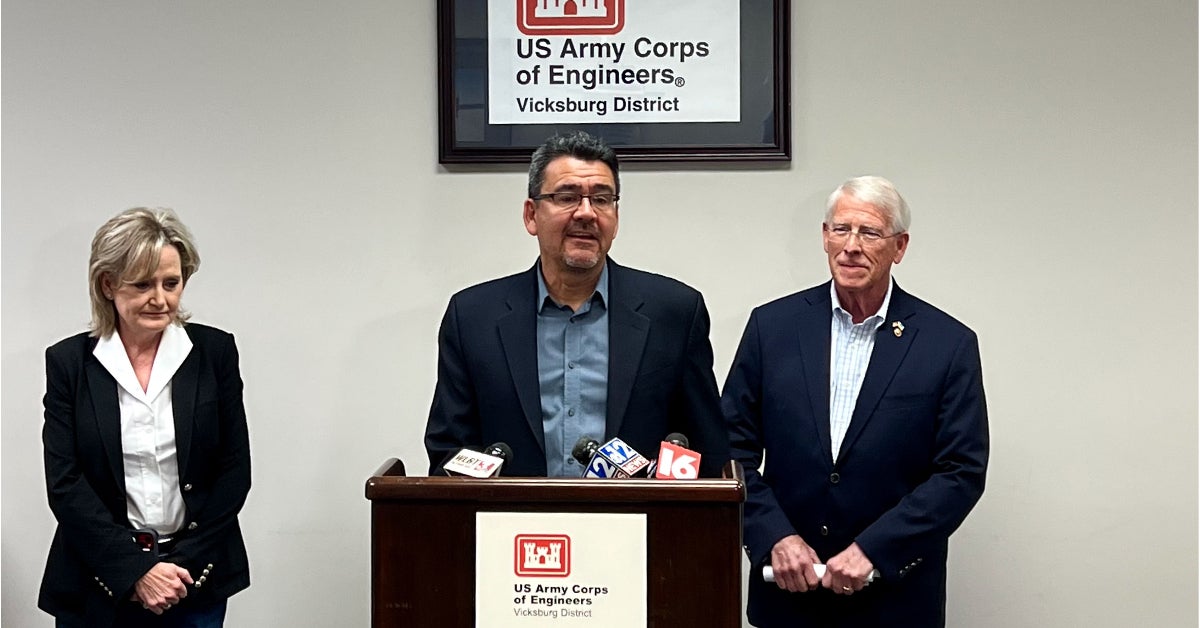Officials to Environmentalists: Science supports Yazoo Backwater Pumps
Published 12:15 pm Friday, May 5, 2023

- Sen. Cindy Hyde-Smith, right, Assistant Secretary of the Army for Civil Works Michael Connor, center, and Sen. Roger Wicker, left, addressed the media Friday at the Vicksburg District. (Photo by Anna Guizerix | The Vicksburg Post)
Conservation groups that are longtime opponents of the Yazoo Backwater Pumps project on Friday released a joint statement again decrying the project’s latest developments.
However, Assistant Secretary of the Army for Civil Works Michael Connor said Friday morning the latest proposal to mitigate catastrophic floods in the area is backed by science.
“Science matters. We put together a plan amongst the resource agencies and the Army Corps of Engineers that we think protects the interests that have been long at issue, which are the fish and wildlife resources and the wetland resources,” Connor said. “I haven’t seen any of the statements, but this is a science-based, technical plan intended to address the issues.”
The U.S. Army Department of Civil Works, Environmental Protection Agency and U.S. Department of Fish and Wildlife on Thursday announced the agencies’ preferred approach for managing floodwaters in the Yazoo Backwater Area.
The groups listed in the statement opposing the project — largely on the basis that a pumping station is included — claim the proposal “flies in the face of the Biden Administration’s decision to put a stop to the Trump Administration’s Yazoo Pumps plan.”
Those groups are: The Audubon Society Mississippi Delta Division; Mississippi Sierra Club, Healthy Gulf, American Rivers and Earthjustice.
“We are stunned that the Biden Administration would choose to advance a plan that abdicates its conservation, climate, and environmental justice commitments by willfully putting the vetoed Yazoo Pumps back on the table,” said Jill Mastrototaro, Mississippi Policy Director for Audubon Delta.
Two variations of the Yazoo Backwater Pumps project have been vetoed in the last 20 years: Once in 2008 and again in 2021.
The difference in the most recent preferred approach, officials say, is that it is a joint collaboration between EPA, Army Civil Works and partner agencies in the U.S. Department of the Interior. Past proposals have been Army Civil Works projects that were presented to EPA upon completion for approval or denial.
Connor, along with Sens. Roger Wicker and Cindy Hyde-Smith, and Gov. Tate Reeves, praised the federal agencies involved for working together to reach this proposed solution.
“My hat is off to the Corps of Engineers and other agencies for working on this,” Wicker said Friday. “This is a major step for the economic development of this region, and I am so glad to have worked with the administration and other members of the congressional delegation (to make this happen).”
Still, conservation activists say the approval — after 80 years of roadblocks to complete the project — is a sign the Biden Administration and agencies under its umbrella have caved to political pressure.
Louie Miller, state director for the Mississippi Chapter of the Sierra Club, said his organization does not believe the science behind the project supports the need for pumps.
“Any course of action that includes resurrecting the ineffective, destructive Pumps not only rings hollow; it signals that political pressures may have trumped science, law and this Administration’s stated priorities,” Miller said.
The statement from the conservation groups included a link to the memorandum of understanding establishing the partnership between Army Civil Works and EPA for the project but did not include scientific data to support claims that a pumping station would have a negative impact on wildlife or wetlands in the Yazoo Backwater area.
Representatives from the Army Corps of Engineers, EPA and Department of Fish and Wildlife all reiterated Friday morning that the proposed water management solution does include non-structural solutions that are environmentally conscious while keeping in mind the negative impact of flooding on humans, infrastructure and wildlife in the area.





